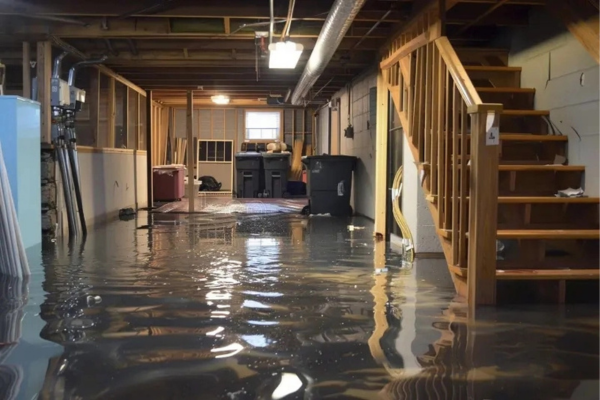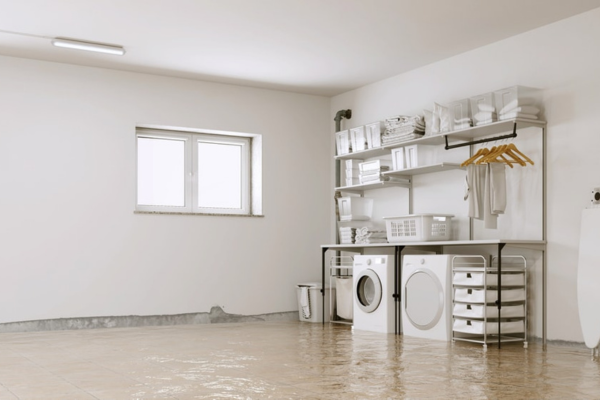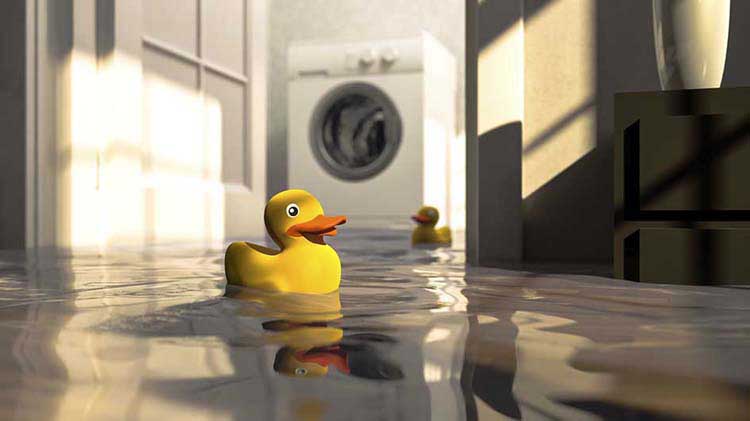Basement Flooding Causes: Understanding
What causes basement flooding? Basement flooding is one of those common issues that many homeowners face, especially during seasons of heavy rains and storms. It destroys very expensive repairs, damages personal belongings, and eventually causes structural issues that may last for a long time. By understanding the primary causes of basement flooding, you can take proactive steps to prevent water damage before it occurs.
Among the most critical variables for protecting your house is to identify the various vulnerabilities within your basements and drainage systems. Knowing what their root causes are could save thousands in repair costs and protect your home from extensive damage-whether through heavy rainfall, poor drainage, or sewer backups.
Our team at Tri State Ready Restoration is dedicated to helping homeowners prevent and recover from a basement flood. Offering expert knowledge in water damage restoration and flood prevention, our services and solutions will help you protect your home from future flooding.
1. Heavy Rainfall and Inadequate Drainage Facilities:

Heavy rainfall is among the most common basement flooding causes. During heavy rainstorms, it is really easy for the water to inundate the drainage systems, or so it were, thus accumulating around the foundation of your house. If the excess water isn’t handled properly, it will find its way to your basement.
Some of the major causes of basement flooding after a heavy rain are poorly draining systems. If your gutters and downspouts are not directing water away from your home, the water pools along the foundation walls, creating pressure that will force its way through cracks or porous surfaces.
The first step to know if the drainage system of your house belongs to the risk group that causes flooding in the basements: During the storm, check for a pool of water around the house’s foundation. Next, check for any clogged or damaged gutters and eliminate them so water can flow without restriction.
Prevention Tips for Heavy Rainfall and Poor Drainage:
- Install proper gutters and downspouts or maintain them to divert water away from your house.
- Ensure that the downspouts extend at least 6 feet away from the foundation.
- For added protection of the home from water accumulation, consider the installation of French drains or a perimeter drainage system.
2. Sewer Backup: The Hidden Cause of Your Flooded Basement
Other major causes of flooded basements involve sewer backups. In these, heavy rain tends to overload the sewer systems, and blockages in the sewer lines are created either by tree roots or aged pipes. This causes wastewater to back up through the drains into your basement, creating a hazardous and very costly cleaning situation.
The most prevalent causes of sewer backups include:
- Buildups within the main sewer line, mostly from tree roots and grease or other debris.
- The inability of aging infrastructure to handle modern-day waste and water flow.
- Heavy rainfall overloading municipal sewer systems and causing backups into homes.
Backup flooding from sewers is not only gross, but it can be dangerous as well; the water involved typically contains contaminants. Thus, any signs of sewer backup must be acted upon immediately to minimize the damage that the situation will inflict on your basement and your home.
How to Prevent Sewer Backup
Prevention Tips:
- A backwater valve installation will prevent sewage water from flowing into your home in the event of a backup.
- Inspection and maintenance on sewer lines regularly to eliminate blockages.
- Avoid putting down the drain grease, wipes, or a large quantity of paper that might block your sewer line.
3. Foundation Cracks and Structural Issues: A major cause of basement flooding.
Crackly foundation walls or floors are one of the common causes of basement flooding. Natural wear and tear, aside from other environmental factors, can have your home’s foundation shift over time and develop tiny cracks in the structure. As water builds up around the foundation, it exploits those weak spots, with water finding its way slowly into the basement.
Shifting soils and hydrostatic pressure are the most prevalent factors in aggravating foundation cracks. This is because when the soil around your home becomes saturated-in the case of heavy rains, for example-the pressure against basement walls increases. It is this relentless force that can cause cracks and further enable water intrusion.
To avoid flooding, one should check for any visible foundation cracks or signs of water seepage, like dampness and discoloration periodically. The problem can exacerbate over time, and that may result in severe water damage.
Prevention Tips for Foundation Cracks:
- Regularly go over your walls and floors to locate cracks or other signs that indicate the presence of moisture.
- Seal all appearing cracks using waterproofing solutions to prevent water percolation.
- Consider the whole foundation with waterproofing for an added layer of protection in case of flooding.
4. Poor Grading Around the Home – A Very Common Cause of Basement Flooding:
One of the most common reasons causing basement flooding is poor grading. Such poor grading allows water to flow toward, rather than away from, the home’s foundation and increases the danger of water accumulation around a home’s basement. Eventually, this may result in leaks, dampness gathering, and finally basement flooding.
To do this, the ground should slope away from the house in such a manner that water will run off and not towards the foundation of your house. If for some reason the soil or landscaping is not properly graded, even light rains can lead to significant accumulations of water, putting your basement at risk of flooding.
Common grading issues may be, but are not limited to, water pooling around the foundation, soil erosion, or visible waterways that move toward your residence. If any of these signs are evident, it is vital that you take necessary steps to remedy this situation to aid in preventing future flooding.
How Not to Have Poor Grading:
- Ensure the yard around your house slopes away from the foundation for at least 6 inches within the first 10 feet.
- Regrade the landscaping as necessary to ensure that it has a downward slope away from the house.
- Install various landscape solutions such as swales or French drains to divert water away from the foundation of the home.
5. Clogged/Broken Sump Pumps: A Cause of Basement Flooding
Because sump pumps collect water that gathers around a house’s foundation and redirect it elsewhere, they are often vital in preventing basements from flooding. However, a faulty or clogged sump pump can easily become one of the leading causes of basement flooding. If it happens during a heavy rainstorm or at the worst time during a power outage, water can rapidly build up inside a basement, flooding it in minutes.
The most common issues that arise with sump pumps are power failures, blocked discharge lines, and not maintaining them. Sump pumps stop working at the worst times because of these reasons, and if not cared for, they will leave your basement flooded.
Sump Pump Facts: In order to function like it should, it is vital for you to periodically test and check your pump. Routine checks will be able to find potential problems before flooding occurs.
Prevention Tips for Defective or Clogged Sump Pumps:
- Testing: Have your sump pump tested on a regular basis so that you know it is working when you will need it-mostly in preparation for heavy rain seasons.
- Install a battery backup system so the pump will continue operation during power outages.
- Periodically inspect the discharge line, cleaning it out of any blockages or potential clogs.
6. Burst Pipes or Plumbing Failures: A Common Cause of Basement Flooding

One of the lesser-expected reasons that could cause basement flooding is a burst pipe or plumbing failure. Chances are, your home grows older, and so does the pipe system running within it, carrying water around. An old or weak plumbing system is most likely to develop cracks, leaks, and extreme conditions that burst pipes, capable of causing flooded basements. Plumbing failures can occur with no warning, especially in homes with old infrastructure.
Frozen pipes are also more prevalent in winter months. Whenever water inside the pipes freezes, it expands, and it exerts serious pressure that causes pipes to burst, with sudden releases of much water, and tends to overwhelm your basement drainage systems, hence fast flooding.
When you are looking at a burst pipe, speed is everything. Shut off the main water supply and call in a professional to assess the damage. The sooner you act, the lesser the water damage and mold growth.
Burst Pipe Prevention:
- Insulate your pipes, especially ones that run through cold areas of the house, such as the basement, crawl space, and garage, against freezing during winter seasons.
- Regularly inspect your plumbing for small leaks and other signs of wear that can lead to a catastrophic failure of the system.
- You may also want to consider the installation of a smart water leak detection system, which can alert you to leaks before they become major issues.
7. Window well leaks: Causes of Basement Flooding
Windows, while allowing daylight to come inside the basement, may also be a liability at the same time. If the seal around the windows is not made properly or if they are old, then water finds its way inside during heavy rainfall or when snow is melting. Small leaks on the edges of the window can sometimes get worse over time and therefore cause substantial water damage.
Besides that, window wells are precisely designed to route the water away from basement windows. However, if not properly serviced, they may become a collecting point for rainwater. If there is accumulated water in the window well, it creates pressure on the window seals and eventually will leak through into the basement.
Prevention Tips for Window Well Leaks:
- Ensure your basement windows are tightly sealed and replace the older ones or damaged ones.
- Install window well covers to keep rain and debris from accumulating in the wells.
- Check for proper drainage of window wells. Clear any blockages that could keep water from draining away.
8. Extreme Weather
Most of the basement flooding incidents occur due to extreme weather events and natural disasters.
The most destructive causes of basement flooding include hurricanes, flash floods, and other extreme weather causes. In these events, the water may rise very fast, causing the drainage system to get overwhelmed and water starts seeping into the basements. Heavy rain and strong winds during hurricanes and storms can cause enough structural damage to a home for it to facilitate ways through which water can find its way inside.
Homes located in areas prone to natural disasters are in danger of basement flooding. Heavy rainfall, snow melting rapidly, and storm surges-the intensities of these then force water into homes, causing massive destruction. Being prepared for these events is the key to preventing basement flooding.
At Tri State Ready Restoration, we understand the severity of lives that weather conditions affect for a homeowner. We’re ready to initiate a prompt response from our professional water damage recovery services to minimize the effects that come after a natural calamity.
Extreme Weather Prevention Tips
- Create an emergency preparedness plan where you need to include the methods of safeguarding your home from any extreme weather.
- Flood-proof the basement by installing sump pumps, backwater valves together with waterproofing systems.
- Make sure the gutters and downspouts are clean of debris to direct rainwater away from the house.
8. Clogged Downspouts
Downspouts are probably among the more commonly overlooked causes of flooding in basements. Downspouts are designed to move water from your roof away from your home’s foundation, but when clogged with leaves and debris or installed poorly, they become funnels right toward it. Once this water pools around the base of your home, it will find its way into your basement and flood it.
Common symptoms of downspouts contributing to basement flooding include pools of water forming near a home’s foundation, obvious debris blocks in the openings of the downspout, and dampness or wetness on the walls of a basement. If your downspouts aren’t long enough to carry runoff away from your house, you are allowing water to drain too close to your house, which can increase your chances for flooding.
Clogged or Broken Downspouts: How to Prevent Them
- Clean downspouts on a routine basis to remove leaves and other debris.
- Make sure these downspouts extend 6 to 10 feet away from your home’s foundation.
- Inspect your downspouts for breaks, blockages, or improper installation and replace or repair if needed.
9. Groundwater Seepage: The Invisible Cause of Basement Flooding
Other possible causes of basement flooding in areas with a high water table are seepages through the ground. Every time heavy rainfall or snowmelt raises the water table, it will seep into the basements through cracks in the foundation or even through porous concrete. This kind of flooding develops rather gradually but can cause extensive damage if left unaddressed.
As the pressure of the water increases, hydrostatic pressure pushes around the foundation of your home and forces water into any weak points. Signs of Groundwater Seepage: Lingering dampness in the basement, water spots on the walls or floors, or mold growth anywhere the area has remained wet for a period of time.
Prevention Tips for Groundwater Seepage:
- Set up a perimeter drainage system, which can be made either from a French drain or weeping tile system. These will redirect the groundwater away from your house.
- Make sure your foundation is waterproof because the proper measures have been taken to do so, especially if you live in an area where the water table is a bit higher compared to the rest.
- Consider installing a sump pump to handle excess groundwater accumulating under your basement.
9. Defective Drain Tile Systems: Leading Cause of Basement Flooding
Other culprits commonly responsible for basement flooding involve malfunctioning drain tile systems. These systems work by routing water away from the foundation of your home, but over time and with gathered debris, they may be clogged or damaged, hindering their proper operation. This can easily cause water to build up around the foundation and therefore flood the basement area.
These systems are commonly set up below the basement floor or around the perimeter to help regulate water pressure and prevent basement flooding. When these systems fail, you may notice pooling water near your foundation, ongoing wet spots in the basement, or even obvious cracks on the visible part of your foundation.
Prevention Tips for Failed Drain Tile Systems:
- Inspect and clean your drain tile system to ensure that it functions with success.
- Clear blockages that block the flow of water away from the foundation.
- Old or damaged drain tile systems should be a target for replacement to prevent future basement flooding.
10. Landscaping or yard features that allow water to collect
One of the more overlooked basement flood causes involves how landscaping and yard features may divert water toward the foundation of your home. Large landscaping features-patios, decks, driveways, and hardscapes-can, at times, create situations in which water collects around the foundation if not installed correctly. If these features do not take proper drainage into account, rainwater will puddle and seep into the ground around your home to ultimately cause basement flooding.
Poor landscaping that slants towards the home instead of away from it will only worsen this condition. Some features, such as a retaining wall or large layering of mulch, can trap water toward the foundation and increase the chance of water entry into the basement. It’s important to ensure all landscaping accommodates proper flow of water and directs runoff away from your home.
Prevention Tips for Landscaping or Yard Features:
- Ensure that all hardscapes and landscaping around the home are appropriately sloped to divert water away from the foundation.
- Install drainage systems around patios and decks, such as French drains, that will enable the water to dissipate away from the house.
- Avoid using impermeable surfaces near the foundation that will hold water against it and causes accumulation.
- Regularly inspect your landscaping and make adjustments as needed to ensure proper drainage.
Protecting Your Home from the Causes of Basement Flooding
Basement flooding has become a great concern for many homeowners; however, basement flooding and the measures to help prevent it can be understood to keep your home safe and dry. There are a variety of causes of basement flooding that range from heavy rainfall and sewer backups to poor grading and faulty sump pumps. Potential weak points in your home’s drainage systems and foundation can be addressed to minimize water damage.
Final Prevention Tips to Keep Your Basement Dry:
- The drainage systems, downspouts, and gutters of your facility must be regularly inspected and kept appropriate.
- Proper grating around your home must be ensured so as to keep the water moving away from your facility foundation.
- Install and maintain sump pumps, backwater valves, and perimeter drainage systems
- Waterproofing of the basement and sealing fractures of foundations
- Prepare for extreme events- Flood Proof your home.
Not sure about your home being vulnerable to basement flooding, or perhaps you have been a victim in the past? Do not wait for the next rainstorm to find out. Contact Tri State Ready Restoration today and have a professional assessment of your situation with detailed solutions to avoid or fix basement flooding. Our team is ready to assist you in protecting your home and ensuring that it will remain dry and secure from future water damage.

